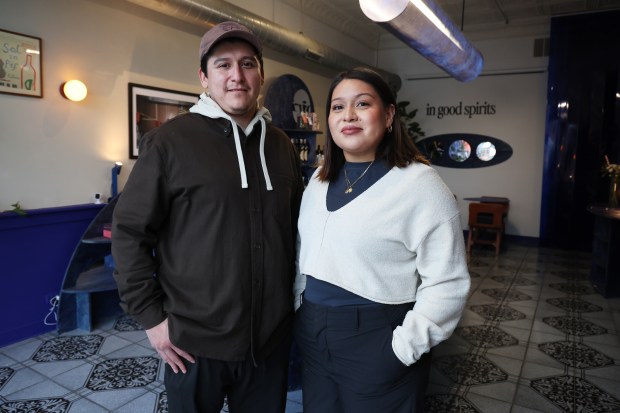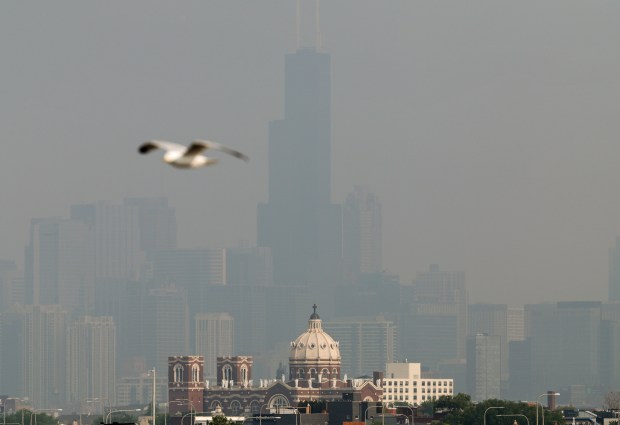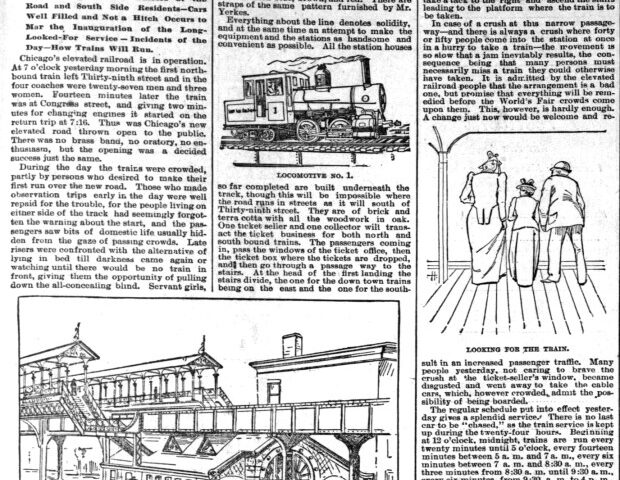As sales of alcoholic beverages have slowed in recent years, nonalcoholic beer, wine and spirits have emerged as one of the fastest-growing sectors in the drinks industry. No longer a niche category for the sober or pregnant, NA drinks are attracting a wide audience of health-conscious, sober-curious or just occasionally alcohol-free consumers too.
For wine lovers, NA options have historically lagged behind beer, the overwhelming market leader. “Wine is still an emerging category in the nonalcoholic space,” says Hector Diaz, who founded In Good Spirits, the West Town nonalcoholic bottle shop and bar, with his partner, Adriana Gaspar. “But it’s gained momentum fast,” he adds, with a big influx of vibrant, creative products reshaping the market.
What is NA wine?
The NA wine sphere consists of two main categories: dealcoholized wines, meaning fully fermented grape wines from which alcohol has been removed, and wine alternatives, also known as wine proxies, not derived from wine.
The gold standard in dealcoholized wines is produced by vacuum distillation, a process invented in 1907 by a German vintner, Carl Jung, that gently extracts alcohol from wines in a vacuum-sealed tank. Carl Jung, his namesake wine estate, remains the industry leader today, producing 15 million-17 million bottles of NA wine annually, including products for many of the world’s top NA-wine brands, including Noughty, Oddbird and Leitz.
The biggest critique of NA wines is that dealcoholization strips wine of its body, concentration and structure — issues compounded when the base wines used had little character to begin with.
At the heart of Carl Jung’s process is a patented aroma recovery system designed to preserve and reintroduce aromatic compounds removed during distillation. These nuances — reminiscent of fruits, flowers, herbs and spices — are essential to preserving the winelike character of NA wine.
As dealcoholization technologies have improved and the NA wine category shifts toward more premium options, it’s possible to find “elegant, worthy NA wines” that come closer than ever to their original counterparts, explains Bernhard Jung, Carl Jung’s grandson, who operates the estate. There are wines that stay “true to the grape varieties used,” he notes, and often carry a recognizable “signature of the winemaker.” Some may even capture “a hint of terroir,” Jung says, that unmistakable sense of origin and place that makes wine such a unique and fascinating product.
Sparkling wines have been most successful in the NA wine category. “They’re the hardest to distinguish from alcoholic versions,” says Jung, because carbonation and added sugar compensate for much of the textural loss of removing alcohol. Dealcoholized versions of lighter-bodied white wines with bold aromatics and fruit flavors are consistently good too.
What wine lovers are most likely to miss are nonalcoholic versions of big, full-bodied reds. Wines with high alcohol content — think any 15% ABV Napa cabernet or Spanish tempranillo — have more to lose when alcohol is extracted, explains Jung.
Indeed, there’s some expectation management “that comes with the territory of being nonalcoholic,” Diaz says. Still, you’ll find plenty of options for increasingly well-made reds, typically lighter, fresh-fruited expressions along the lines of an easy-drinking gamay or pinot noir.
Proxies and wine replacements
In contrast to dealcoholized wine, wine alternatives, or proxies, often claim to replicate the wine-drinking experience rather than the wine itself. Instead of removing alcohol from wine, proxies take cues from cocktail mixology, building drinks with flavor, aroma and structural depth from an array of nonwine ingredients. The best rely on natural juices and teas or ferments such as kombucha, along with botanical, rather than artificial, flavorings and enhancements.
For Hardy Wallace, the prominent Napa winemaker and owner of Extradimensional Wine Co. Yeah! in California, fermentation is key to a wine replacement with depth. “To me, alcohol-removed wine is like having soy chorizo,” he explains. “If I want to drink something that’s no-alcohol, I want a high-quality, crafted beverage that’s not trying to be wine.” Among his favorites are fermented teas made by Unified Ferments. “They’re basically super high-end kombucha,” Wallace says, but “with incredible nuance.”
Complex blends of ferments and gastronomy-inspired techniques such as dry carbonic maceration and wood smoking are foundations of Muri, the Copenhagen-based brand of wine alternatives. Drawing on a wide array of ingredients, from foraged fruits and herbs to lacto-fermented vegetables and kefir, Muri has become a standout brand increasingly featured in some of America’s top restaurants.
The brand Proxies is another visible player in the wine-alternative space, thanks in part to savvy social media marketing and high-profile collaborations with chefs and sommeliers. Made from a base of unfermented grape juices boosted with a variety of fruit concentrates, teas, spices, herbs and botanicals, Proxies are interesting drinks with a textural richness that outshine almost any other products in the NA wine sphere. A potential drawback, however, is ingredients such as vegetable glycerin, a derivative of plant oils, added to mimic the mouthfeel of wine, or food preservatives such as sodium benzoate.
A community for sober counterculture
With so many new NA options on the market, a surge of online retailers and direct-to-consumer platforms have developed too. Online purveyors such as The Zero Proof and Boisson help streamline the sea of choices. But brick-and-mortar stores, such as In Good Spirits, can help build a sense of community within the sober and sober-curious counterculture that’s fresh and meaningful, Diaz explains.
“Creating a safe space for the sober community is very important to us,” says Diaz, but the growing mainstream appeal of NA alternatives has been energizing too. “It speaks volumes about society in general,” he says. “People are becoming more mindful about how they’re consuming alcohol and making thoughtful changes to their lifestyle.”
NA wine and wine alternatives worth seeking out:
Dealcoholized Wines
Dr. Lo Riesling with Bubbles, $17 at binnys.com
This intensely aromatic NA riesling sparkler made by Dr. Loosen, one of Germany’s most celebrated wine producers, could fool most tasters into thinking they’re drinking the real deal. Crafted from high-quality riesling grapes sourced from the Mosel Valley, its intensely slatey minerality, concentrated green apple flavor and spine-tingling acidity are exceptionally true to the classic Mosel style. Elegantly effervescent and just a shade off-dry, it’s a standout bargain for a truly top-tier NA wine. Dr. Lo’s still Riesling is also top-notch.
Leitz Zero Point Five Non-Alcoholic Pinot Noir, $20 at thezeroproof.com
Leitz is another example of a heavy-hitting German winemaker equally committed to serious NA wines. It’s hard to choose a favorite from their impressive lineup of products — their sparkling wines, still chardonnay and riesling are all very good. But this light-bodied yet juicy German pinot with crisp cassis and black-cherry flavors might be the most convincing NA pinot on the market.
Oddbird Blanc de Blancs Sparkling White, $25 at thezeroproff.com
A blend of chardonnay and colombard grapes sourced from the Languedoc-Rousillon region in France, Oddbird’s white wine sparkling “is unanimously well received,” Diaz says. Matured 12 months before dealcoholization, it’s one of the few NA sparkling wines with hints of toasted caramel and nut reminiscent of Champagne. For red wine lovers, Oddbird’s GSM, a classic grenache-syrah-mourvèdre blend is popular too, Diaz says.
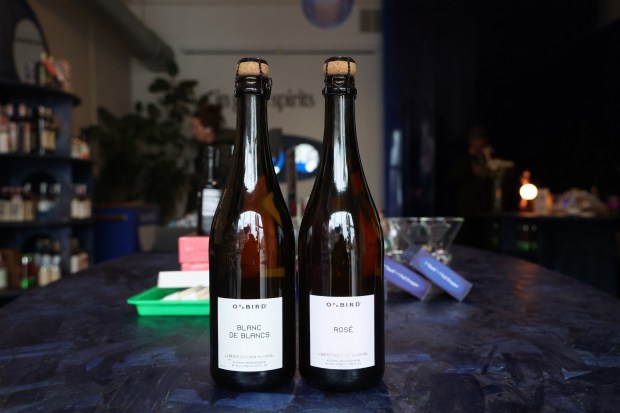
Noughty Dealcoholized Sparkling Rosé, $22 at us.noughtyaf.com
For lovers of rosé fizz, this salmon-pink sparkling made from organic tempranillo grapes offers perfumed raspberry and red-cherry flavors balanced with brisk acidity and very fine, penetrating effervescence.
Wine Alternatives
Unified Ferments Rhododendron, $29 at shop.unifiedferments.com
Unified Ferments aren’t marketed as wine alternatives, but these NA beverages, fermented from single-origin teas, achieve remarkable complexity through minimal ingredients and processing. Rhododendron is crafted from a tea base of wild-harvested rhododendron leaves fermented with a kombucha starter. It’s vibrantly fresh, a little funky and delicately herbaceous, a bit reminiscent of a saline Muscadet or Chablis.
Muri x The Four Horsemen, $38 at muri-drinks.com
This subtly spicy, red-fruited drink is a high-profile collaboration between Muri and The Four Horsemen, the Michelin-starred wine bar in Brooklyn, New York, owned by LCD Soundsystem’s James Murphy. Made from a base of sour cherries and tomato water, it’s a supple, remarkably finessed sip with savory inflections of salted beetroot and green peppercorns.
NON1 Salted Raspberry & Chamomile, $30 at us.non.world
Diaz singles out NON for wine alternatives that are “very complex, very funky and unique in flavor profile.” The Australian brand relies on a base of cooked fruits, here, freeze-dried raspberries blended with verjus, the juice of unripe grapes for acidity. Delicate tannins from chamomile tea and pops of salinity make this a zesty, thirst-quenching drink reminiscent of rosé.
Proxies Red Ember, $25 at drinkproxies.com
Proxies have sold particularly well at In Good Spirits, says Diaz, and products such as their Red Ember or Big Red are suited to red wine lovers. Red Ember is made from unfermented cabernet sauvignon and pomegranate juices augmented by a fascinating array of flavorings, extracts and structural enhancements.
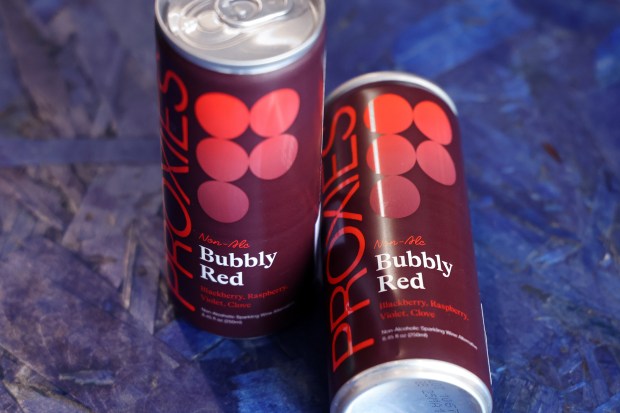
Anna Lee Iijima is a freelance writer.


